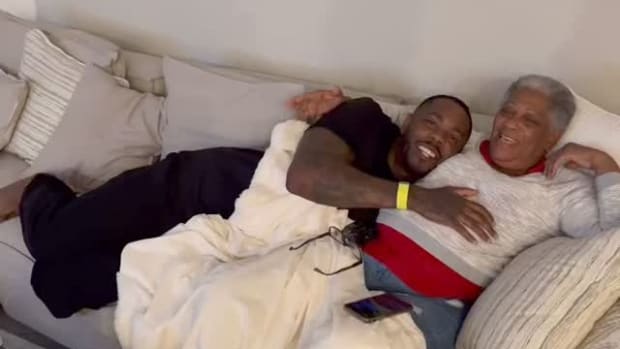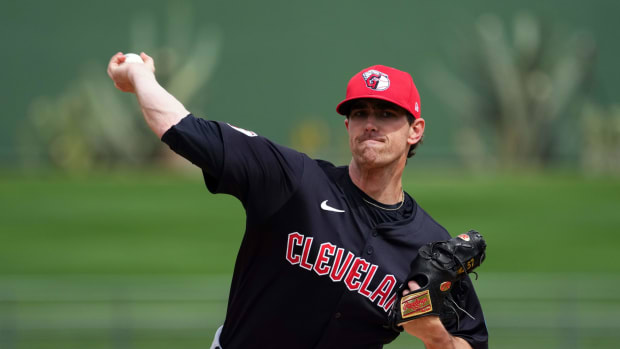MLB Center Fielders Have Never Been Worse
Does your team need a center fielder? Two pieces of advice: get in line and keep your expectations low.
Center field is one of baseball’s traditional glamour positions. When Paul Simon conjured the yearning for the great American role model, John Fogerty sang about a return to limelight and Terry Cashman captured the lyrical essence of talkin’ baseball, all looked to center field. Now, when our nation turns its lonely eyes to center field, it sees the worst the position has been in half a century.
Center fielders last season hit .237 with a .303 on-base percentage and .688 OPS, the worst marks in each category at the position in at least 50 seasons (since 1973, when complete records by position are available).

Cody Bellinger has slashed .203/.272/.376 since he won the NL MVP award in 2019.
Jeff Hanisch/USA TODAY Sports
At least 12 teams need a center fielder for 2023. The best available free agents include two players who are not likely long-term solutions in center field (Aaron Judge and Brandon Nimmo), one player who has hit .203 over his past 1,143 plate appearances (Cody Bellinger) and one soon-to-be 33-year-old coming off hip surgery (Kevin Kiermaier).
What happened? How did we get here? Is there hope center field is climbing out of this down cycle? Let’s start by defining the problem:
2022 MLB Centerfield Production
| Rank in Past 50 Seasons | Previous Low | ||
|---|---|---|---|
Batting Average | .237 | Lowest | .244 in 2021 |
On-Base Percentage | .303 | Lowest | .318 in 2021 |
Slugging Percentage | .385 | 4th Lowest | .370 in 1989* |
OPS | .688 | Lowest | .691 in 1989 |
SB Per Game | 0.17 | Lowest | 0.19 in 1973 |
*Still the lowest
- The five worst batting averages for center fielders in the past 50 seasons have all occurred in the past five seasons.
- The National League All-Star team last season did not include a center fielder among its eight outfielders.
- The two World Series teams, the Astros and Phillies, ranked 23rd and 27th, respectively, in center field OPS.
- The Guardians became only the fifth team in the past 50 seasons with no home runs from center fielders.
- Oakland center fielders hit .184, the worst at the position in any full season since 1973.
- The Guardians, A’s and Rays all posted 50-year franchise lows for center field OPS.
- Four teams did not reach a .600 OPS in center field (Guardians, A’s, Rays, Astros). No other full season since 1973 had more than two such teams.
- Only four qualified center fielders (with at least 100 games in center) posted an above-average OPS+: Nimmo, Bryan Reynolds, Cedric Mullins and Julio Rodríguez. In 2015, there were 12.
- From 1931 to 2019, there was never a full season with as few as four qualified center fielders (with at least 100 games in center) with above-average offense. It has happened in each of the past three full seasons (only three in ’19, four in ’21, four in ’22).
One reason for the decline of center field play: Injuries have limited Mike Trout, Byron Buxton, George Springer and Luis Robert.
Elite everyday center fielders are a rarity. Over the past four seasons, the players with the most starts in center field are Victor Robles (390), Mullins (341) and Myles Straw (321). The number of players who started a game in center field jumped 28% in a decade, from 132 in 2012 to 169 in ’22.
The next generation of elite center fielders failed to take root. For instance, the top center field prospects of 2017 were Robles (ranked eighth overall by MLB.com), Bellinger (13th), Lewis Brinson (18th), Mickey Moniak (19th), Bradley Zimmer (22nd), Manuel Margot (23rd), Kyle Lewis (29th), Corey Ray (30th) and Blake Rutherford (37th), all of whom were listed ahead of Judge (46). The two prior top 100 prospect lists included Buxton, Dalton Pompey, Albert Almora Jr., David Dahl, Brett Phillips, Daz Cameron, Trent Grisham and Roman Quinn.
That’s not a knock on prospect lists. Such players generally get on such lists because of showcase tools. But as technology advanced and pitching labs became as important as pitching mounds, pitching changed drastically. From 2015 to ’22, average fastball velocity jumped from 92.7 mph to 93.7, and the spin rate on those heaters increased by 40 rpm.
But the even bigger change came with spin. As fastballs grew in velocity, pitchers threw them less—from 57% in 2015 to 49% in ’22, the first time in recorded history that the fastball was not the majority foundation of pitching. Breaking pitches in that same period grew from 25% to 31%, while their spin jumped by 263 rpm, a 12% increase.

Buxton leads all MLB center fielders with 10.6 WAR since 2020, despite playing in only half of the Twins’ games in that three-season span.
Kamil Krzaczynski/USA TODAY Sports
Athletic tools are no longer enough to predict major league success. Minor league hitters just don’t see the same spin as what awaits them in the big leagues. Swing decisions on breaking pitches have become the more important predictive tool over the ability to hit velocity. That’s because most breaking pitches are not strikes—56% of them are thrown outside the zone. And trying to hit breaking pitches out of the zone is a ticket out of the big leagues. Batters hit .122 against them last season.
Take Brinson as an example. When he first appeared as a top-20 prospect in 2016, he had just posted a .332/.403/.601 slash line at age 21 across three levels in the Rangers system. Texas traded him later that year to the Brewers, who traded him two years later to the Marlins as the centerpiece return in the Christian Yelich deal. Across six major league seasons, Brinson has seen an above-average rate of breaking pitches (37%) and hit just .134 against them, including .068 on breaking pitches out of the zone. He has swung at 347 of them in his career and managed 11 hits.
If it has become harder to develop center fielders, what about buying one? The Blue Jays spent $150 million over six years on George Springer, starting with his age-31 season. Two years into the deal, injuries have limited him to starting only 38% of Toronto’s games in center field. His future looks more like it will be played in a corner spot.
Judge turns 31 in April. He loves playing center field and did log a career-high 78 games there last season. But with his impact bat, and at his age and size, he will play mostly in right.
Nimmo turns 30 in March and is hitting the market at the perfect time: when left-handed hitting and center fielders are scarce. His career OBP of .385 is attractive. But Nimmo is not without some shortcomings.
Nimmo never has been a premier defender in center field. Last year he moved seven feet deeper to play an average of 330 feet from home plate, the deepest center field in the majors and nine feet deeper than league average. Such a tactic might improve defensive metrics, as sketchy as they are, because it is designed to allow fewer extra base hits. But it comes at the cost of more singles, and in this case, Nimmo does not have the arm strength to justify playing the deepest center field in baseball.
He profiles better on defense in left field but on offense in center field. His offensive game relies on walks and hit by pitches, not power or baserunning.
One other issue for Nimmo is that center field has become a young man’s position, as the injuries to Springer have helped illuminate. Last season no player age 30 or older played 100 games in center field and had enough plate appearances to qualify for the batting title. Over the past three full seasons, only five times has a 30-something player held down center field with such regularity: Lorenzo Cain and Kevin Pillar in 2019, Starling Marte in ’19 and ’21 and Michael A. Taylor in ’21. In ’17 alone it happened five times. In 1998 it happened 10 times. Two years later, four of the six All-Star center fielders were at least 30 (Ken Griffey Jr., Jim Edmonds, Bernie Williams and Steve Finley).
Teams prefer young legs in center field, which is why teams are lining up to take a one-year chance on Bellinger, 27, who plays the shallowest center field in the business and does it well. His fall offensively from MVP to non-tender within three years (and just 295 games) is unprecedented for a star so young. His troubles were exacerbated by shoulder surgery after that 2020 (Shoulder) Shot Heard Round the World, when he celebrated a home run by violently bashing arms with Enrique Hernández. The loose-limbed Bellinger has been fighting to find the same form with a shoulder capsule that had to be tightened.
Bellinger once thrived on pure athleticism in the box. He stands stock still and does not generate movement until the pitcher gets to release point—a risky approach as velocity at the top of the zone has become a staple of pitching and as he ages with a rebuilt shoulder. Bellinger hit .120 on high fastballs last season, making 71 outs on the pitch, seventh most in baseball. His launch angle has increased. His plate discipline has worsened with more experience; he set a career-worst chase rate in 2020, again in ’21 and again in ’22.
And yes, spin is causing him massive difficulties. Hard as this is to believe, Bellinger has hit worse against breaking pitches with each year in the big leagues: .272, .257, .242, .191, .183, .140. Last season he made a career-high 51 outs chasing breaking pitches out of the zone.
Don’t think the Dodgers have not tried to fix Bellinger. What he needs is new scenery and—more than a hitter-friendly ballpark or the highest guaranteed salary offered to him—a new hitting voice. He should sign quickly with a guru who can overhaul his swing and develop a more sustainable approach. None are better, especially with left-handed swings, than Kevin Long of the Phillies. Every week of the offseason counts when it comes to rebuilding a swing.
There still is more in there. As bad as he was last season, Bellinger was one of only three players last season to hit 19 homers and steal 14 bases while playing center field. The others were Rookie of the Year Award winners Rodríguez of the Mariners and Michael Harris of Atlanta.

At 21, Rodríguez is already one of the game’s brightest stars. He represents the promise of the next wave of great center fielders.
Lindsey Wasson/USA TODAY Sports
And that brings us to the good news about center field. Rodríguez and Harris are only 21 and mark the first time both rookie award winners have played center field. Riley Greene showed promise with the Tigers. Like Rodríguez and Harris, Greene is entering his age-22 season. The Diamondbacks have Alek Thomas, who turns 23 in April, and Corbin Carroll, 22. The next wave could include Jackson Chourio, who will be 19 next season, of Milwaukee, Druw Jones, 19, of Arizona, and James Wood, 20, and Robert Hassell III, 21, of Washington.
After hitting a 50-year low, the land of Joe DiMaggio and Willie, Mickey and the Duke just might be on the upswing.
More MLB Coverage:
• Baseball Bargains: Five Underrated Free Agents Still Available
• Bryce Harper’s Injury Casts Shadow Over Phillies’ 2023 Plans
• Building the Best Red Sox Team for 2023
• Building the Best Blue Jays Team for 2023
• How Banning Infield Shifts Will Change MLB


































